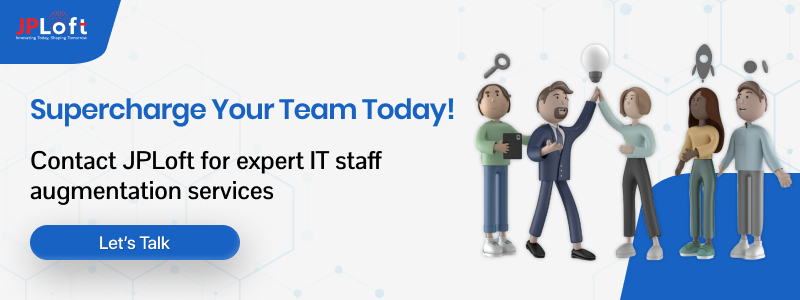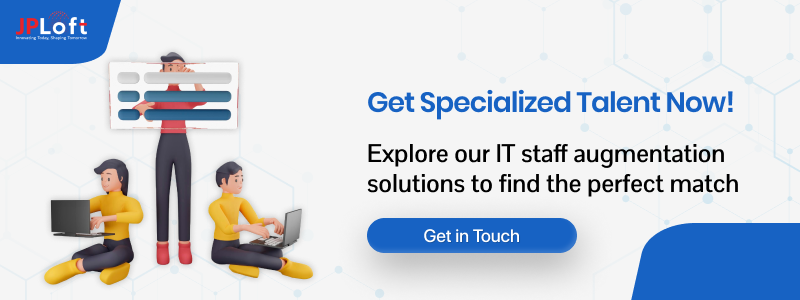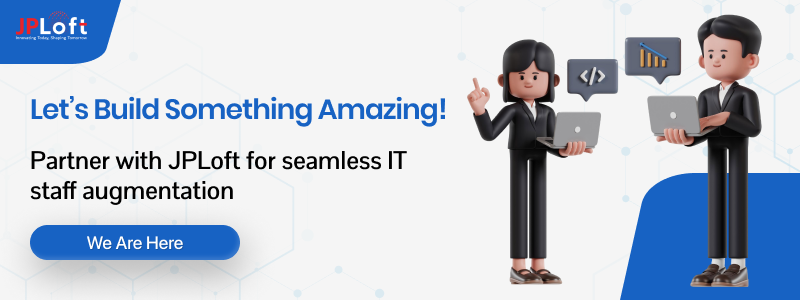Ever faced a moment where your software development team needed extra hands or specialized skills to complete a project on time? That’s exactly where IT staff augmentation becomes a game-changer.
This flexible hiring approach allows you to bring in skilled IT professionals to support your team, whether it’s for short-term needs or long-term projects. Think of it as a way to access the talent you need, when you need it, without the overhead of full-time hiring.
In this blog, we’ll explore how IT staff augmentation works, its benefits for software companies, and why it’s becoming a go-to solution for businesses worldwide.
What is IT Staff Augmentation?
Have you ever found yourself in the middle of a critical IT project and realized you don’t have the right team or skills to see it through? That’s where IT staff augmentation steps in as a solution.
In simple terms, IT staff augmentation is a flexible hiring model that allows businesses like yours to bring in specialized IT talent on a temporary or project-based basis. Whether you need one developer or an entire team of experts, staff augmentation helps you scale your workforce quickly without committing to long-term employment contracts.
This model works like a bridge, connecting your in-house team with skilled professionals to fill gaps, meet deadlines, or tackle specialized tasks. Unlike outsourcing, you retain complete control over the project, while the augmented staff integrates seamlessly into your workflows.
Types of IT Staff Augmentation: Finding the Right Fit for Your Business
IT staff augmentation is not a one-size-fits-all solution. It offers flexibility to cater to different business needs, ensuring that companies get exactly what they require.
Understanding the various types of staff augmentation can help you choose the best approach for your projects and goals. Below is a comprehensive breakdown of the types of IT staff augmentation and what each entail.
1. Skill-Based Augmentation
Skill-based augmentation focuses on hiring professionals with expertise in specific technologies, tools, or frameworks. This type is ideal when your in-house team lacks certain technical skills critical for project execution.
When to Use Skill-Based Augmentation:
-
- When your project requires niche expertise, such as blockchain development, DevOps practices, or AI/ML modelling.
- If you need specialists for tasks like data migration, cloud integration, or cybersecurity improvements.
- For businesses looking to integrate the latest tools and technologies without upskilling their internal teams.
Advantages:
-
- Access to specialists with deep expertise in a particular domain.
- High-quality results delivered by professionals familiar with best practices.
- Eliminates the need for training or upskilling in-house staff.
2. Short-Term Staff Augmentation
Short-term staff augmentation is designed to address immediate and temporary needs. It’s a popular choice for businesses facing tight deadlines or unexpected resource shortages.
When to Use Short-Term Augmentation:
-
- To meet tight project deadlines without overburdening your existing team.
- During peak project phases that require additional hands, such as product launches or critical updates.
- For handling specific tasks within a defined timeframe, such as testing, debugging, or feature development.
Advantages:
-
- Quick access to additional resources for urgent requirements.
- Reduces workload on the core team, preventing burnout.
- Cost-effective for temporary needs, as resources can be scaled down once the project is completed.
3. Long-Term Staff Augmentation
Long-term staff augmentation is ideal for businesses that require consistent support over an extended period. It’s especially beneficial for organizations working on large-scale projects or maintaining complex systems.
When to Use Long-Term Augmentation:
-
- For projects with long development cycles or ongoing maintenance needs.
- When your business needs dedicated support for managing evolving technologies, such as cloud platforms or enterprise software.
- To create a stable team without committing to permanent hires.
Advantages:
-
- Builds a strong, consistent team that understands your company’s processes and goals.
- Reduces costs compared to full-time hiring, as resources are contracted only for the required duration.
- Provides the flexibility to scale as your needs change.
4. Project-Based Staff Augmentation
Project-based augmentation is a focused approach where resources are hired specifically for a single project. This type is highly effective for businesses with defined goals and timelines.
When to Use Project-Based Augmentation:
-
- For developing an MVP (Minimum Viable Product) or launching a new feature.
- To handle standalone projects like migrating systems, building an app, or deploying a website.
- For completing projects that require expertise unavailable within your team.
Advantages:
-
- Resources are dedicated solely to your project, ensuring high focus and efficiency.
- Faster execution as professionals bring relevant experience and pre-existing knowledge.
- Avoids the long-term commitment of traditional hiring.
5. Part-Time or Fractional Staff Augmentation
Part-time or fractional augmentation allows you to hire resources on a part-time basis, making it an economical option for businesses with limited workloads or budgets.
When to Use Fractional Augmentation:
-
- For tasks that don’t require full-time involvement, such as periodic system updates or consultancy services.
- To gain access to expertise without investing in a full-time role.
- For start-ups or smaller businesses with limited but critical technical requirements.
Advantages:
-
- Cost-effective for businesses with smaller budgets.
- Provides access to highly skilled professionals for specific tasks.
- Allows flexibility in scheduling, ensuring resources are only engaged when needed.
6. Offshore and Onshore Staff Augmentation
Staff augmentation can be categorized based on the geographic location of the resources, offering businesses additional flexibility.
When to Use Offshore and Onshore Staff Augmentation:
-
- When looking to reduce development costs while still accessing skilled talent.
- If you quickly scale the team and maintain productivity across different time zones, this can be a great option.
- In case, your project requires specific expertise that might not be available locally, especially in niche or highly specialized technologies.
Advantages:
-
- Significant cost savings and access to a broader range of talent without being limited by geographical boundaries.
7. Functional or Role-Based Staff Augmentation
This type of augmentation focuses on hiring resources to fill specific functional roles, such as developers, testers, project managers, or UI/UX designers.
When to Use Functional Augmentation:
-
- When your team lacks a specific role critical to project success.
- To improve team efficiency by adding specialists to handle defined responsibilities.
Advantages:
-
- Clear role definitions ensure minimal overlap and maximum productivity.
- Functional specialists bring domain knowledge and targeted expertise.
Selecting the right type of staff augmentation depends on your business goals, project scope, and budget. Whether you need short-term support, niche expertise, or a dedicated team for a long-term project, understanding these categories will help you make informed decisions.
IT staff augmentation offers unparalleled flexibility, helping businesses tackle talent shortages effectively. By choosing the right type of augmentation, you can optimize your team, meet deadlines, and stay ahead of the competition.
How IT Staff Augmentation Works?
IT staff augmentation is like having a safety net for your workforce - it’s there when you need it, without the long-term strings attached.
Here’s how it works:
-
- Identify Your Needs: The first step is assessing your project or business requirements. Do you need developers, QA testers, or cloud specialists? Or maybe a mix of everything for a big project? Pinpointing these needs helps you find the right professionals.
- Partner with a Staff Augmentation Company: A trusted IT staff augmentation company acts as your talent provider. They have a pool of pre-vetted professionals ready to join your team. You don’t have to spend weeks recruiting and screening; they handle it for you.
- Select and Onboard Talent: Once the company presents candidates that match your requirements, you interview and handpick the right fit. From there, onboarding is simple - the professionals join your team and start working as if they’ve been with you all along.
- Collaborate and Deliver: The augmented staff integrates into your in-house team, working under your leadership. This model ensures complete control over the project while benefiting from their specialized skills and experience.
- Scale Up or Down as Needed: One of the best things about IT staff augmentation? Flexibility. If your project scales or you no longer need certain skills, you can adjust the team size without any hassle.
This model is particularly useful for businesses needing temporary expertise, meeting tight deadlines, or handling fluctuating workloads. And the best part? You get the skills you need without the overhead costs of full-time hiring.
Benefits of IT Staff Augmentation
Why should IT staff augmentation be on your radar? The answer lies in the many advantages this flexible hiring model brings to the table. Let’s take a closer look at how it can make a difference for your business.
1] Access to Specialized Skills Without Long-Term Commitment
Picture this: You’re working on an AI-driven app but realize your in-house team doesn’t have the expertise to implement machine learning algorithms. Sound familiar? IT staff augmentation solves this by giving you access to a vast pool of specialized talent.
Whether you need blockchain developers, cybersecurity analysts, or cloud architects, you can bring in experts with the precise skills your project requires. The best part? You don’t have to commit to these specialists long-term - use their skills for the duration of your project and scale down when it’s complete.
This targeted approach ensures you’re not wasting time or resources training your internal team on a skill they might never use again.
2] Flexible Team Scaling to Match Project Demands
Projects often come with unexpected twists and turns. Deadlines change, scopes expand, and suddenly, your team is overwhelmed. With IT staff augmentation, you can scale your team size up or down as needed.
For instance, if your e-commerce business experiences a spike in demand during the holiday season, you can quickly bring in additional IT support to manage the surge. When the season ends, you can reduce the extra staff without any long-term obligations.
This flexibility means you’re always prepared, no matter how your workload fluctuates. It’s a smart way to ensure your business remains agile and competitive.
3] A Cost-Effective Alternative to Traditional Hiring
Hiring full-time employees can burn a hole in your budget. You’re not just paying salaries; you’re covering benefits, insurance, office space, training, and more. For short-term projects, these costs can outweigh the benefits of having in-house talent.
IT staff augmentation eliminates these overheads. You only pay for the professionals you need, for the time you need them. Plus, you avoid expenses like recruitment, onboarding, and long-term benefits.
This cost-effective approach is especially valuable for startups or companies working within tight budgets, allowing you to allocate resources where they’re needed most.
4] Accelerated Hiring Process to Meet Tight Deadlines
Time-sensitive projects require fast action, but traditional recruitment processes can drag on for weeks or months. From posting job ads to interviewing and onboarding, you might lose precious time.
Staff augmentation companies streamline this process. They already have a pool of pre-vetted IT professionals who are ready to start immediately. You can skip the lengthy recruitment cycle and focus on what matters - delivering your project on time.
For businesses juggling multiple deadlines, this speed can make a significant difference.
5] Retain Complete Control Over Your Projects
One major concern with outsourcing is losing control over your projects. External teams often work independently, making decisions that might not align with your company’s vision.
With IT staff augmentation, that’s not an issue. The augmented staff work directly under your supervision, following your processes and adhering to your goals. They integrate into your workflows, ensuring the quality and direction of the project remain in your hands.
This model gives you the best of both worlds: external expertise combined with internal control.
6] Seamless Integration with Your In-House Team
You might wonder, “How will an external professional fit into our team?” The answer lies in the adaptability of augmented staff.
These professionals are experienced in joining new environments quickly. They adapt to your company culture, workflows, and tools, ensuring minimal disruption.
For instance, if your team uses Agile or DevOps methodologies, the augmented professionals are already familiar with these approaches, making the transition smooth. It’s like they’ve been part of your team all along, but without the long-term strings attached.
7] Focus on Your Core Business Goals
Managing IT staffing challenges can take your focus away from strategic business objectives. With IT staff augmentation, you don’t have to worry about recruitment, onboarding, or filling skill gaps. The augmentation company handles these logistics for you, allowing you to focus on driving innovation and growth.
This freedom lets you allocate your time and resources to areas that truly matter, ensuring your business stays ahead in a competitive market.
IT staff augmentation is more than just a hiring model - it’s a smart strategy for businesses looking to tackle complex projects, manage fluctuating workloads, and stay competitive.
IT Staff Augmentation vs. Traditional Outsourcing
Both IT staff augmentation and traditional outsourcing help businesses access external talent, but the way they operate and the benefits they offer are quite different.
Here’s a clear side-by-side comparison to help you understand which model suits your needs better:
|
Aspect |
IT Staff Augmentation |
Traditional Outsourcing |
|
Control Over Project |
You retain complete control over the project and processes. |
The outsourcing team manages the project independently. |
|
Team Integration |
Augmented staff integrates with your in-house team. |
Outsourced teams work separately from your team. |
|
Flexibility |
Scale your team up or down based on project needs. |
Fixed scope and contract; limited flexibility. |
|
Expertise Needed |
Provides specific skillsets to fill gaps in your team. |
Offers a full-fledged team for end-to-end project delivery. |
|
Management Responsibility |
You manage the augmented staff directly. |
The outsourcing vendor handles team management. |
|
Cost Structure |
Pay only for the resources and duration you need. |
Typically involves a fixed or milestone-based payment model. |
|
Best Suited For |
Short-term or highly specialized needs within a project. |
End-to-end delivery of well-defined projects. |
|
Project Ownership |
You own the project outcomes and processes. |
The vendor owns the project delivery and execution. |
|
Speed of Hiring |
Faster onboarding due to pre-vetted talent pools. |
Longer setup as the vendor builds a team and defines scope. |
|
Customization |
High customization since staff work under your processes. |
Limited customization due to vendor-defined workflows. |
► When to Choose IT Staff Augmentation
-
- You need additional hands or specialized expertise for a specific project.
- You want to maintain control over your project and workflows.
- Flexibility and scalability are important to you.
► When to Choose Traditional Outsourcing
-
- You want an external team to handle a project from start to finish.
- Your project has a well-defined scope and timeline.
- You don’t want to manage additional resources directly.
This comparison highlights the fundamental differences, helping you decide which model aligns with your business needs.
Use Cases for IT Staff Augmentation in Software Development
For software development companies, IT staff augmentation is more than just a solution - it’s a strategy to meet the ever-changing demands of the industry.
From scaling your teams to tackling complex projects, staff augmentation provides the agility and expertise you need to stay competitive. Let’s explore how this model fits perfectly into the software development landscape.
A] Scaling Development Teams for Large Projects
Software development projects often demand rapid team expansion. For example, building a SaaS platform or developing a custom mobile application might require additional developers, testers, or UI/UX designers.
IT staff augmentation lets you scale up your team quickly with skilled professionals, such as front-end developers, back-end engineers, or full-stack experts, ensuring your project remains on schedule. Once the project is complete, you can scale down without long-term commitments.
B] Meeting Aggressive Project Deadlines
Deadlines in software development are often tight, especially when you’re dealing with product launches, feature rollouts, or system upgrades. Augmenting your team with additional software developers or project managers ensures that your in-house team isn’t overwhelmed while keeping timelines on track.
For instance, if you’re upgrading a legacy system to a modern framework, adding temporary skilled developers through IT staff augmentation can significantly speed up the process.
C] Accessing Niche Technical Expertise
In software development, some projects require expertise in specialized technologies like machine learning, blockchain, or IoT. Hiring full-time staff for short-term needs can be costly and inefficient. IT staff augmentation allows you to bring in niche experts who specialize in these technologies for the duration of your project.
For example, if you’re developing a blockchain-based payment system, you can augment your team with blockchain developers without the hassle of permanent hiring.
D] Supporting Startups with Limited Resources
Startups in the software industry often face the challenge of limited budgets and resources but still need access to top-tier talent. IT staff augmentation offers a cost-effective way to gain skilled developers, DevOps engineers, or QA testers to build and deploy your product.
For instance, a startup launching its first mobile app can use staff augmentation to onboard Android and iOS developers, UI/UX designers, and testers to handle the project efficiently.
E] Handling Seasonal Demand in Software Projects
Software development companies may experience seasonal demand spikes - like holiday e-commerce feature upgrades or annual performance reviews for SaaS platforms. Augmenting your IT staff during these times helps manage the workload effectively.
For example, an e-commerce platform preparing for the holiday season might require additional developers to implement new features, optimize the backend, or strengthen cybersecurity measures.
F] Filling Talent Gaps in Software Development Teams
Even the most experienced in-house teams might have gaps in certain skill areas. Whether you’re missing a DevOps specialist to streamline CI/CD pipelines or a database architect for a complex migration, IT staff augmentation fills these gaps seamlessly.
This ensures that your software projects progress without compromising quality or timelines.
In the software development industry, agility and expertise are non-negotiable. IT staff augmentation provides the perfect solution to adapt to changing project requirements, meet deadlines, and access specialized talent - all while keeping costs under control.
Challenges in IT Staff Augmentation (and How to Overcome Them)
While IT staff augmentation offers numerous advantages for software development companies, it’s not without its challenges. Knowing these hurdles upfront can help you address them effectively and get the most out of this hiring model.
1. Communication and Collaboration Gaps
When integrating external developers or engineers into your in-house team, communication can sometimes become a stumbling block. Differences in work styles, time zones, or even language barriers can impact collaboration.
Solution:
-
- Use collaborative tools like Slack, Microsoft Teams, or Jira to keep communication seamless.
- Establish clear protocols for reporting, stand-ups, and feedback.
- Partner with a reliable staff augmentation company that prioritizes professionals with excellent communication skills.
2. Cultural and Workflow Integration
Augmented staff may come from different professional backgrounds, and aligning them with your company culture and workflows can take time. This challenge is especially significant in software development, where methodologies like Agile or Scrum require close team synchronization.
Solution:
-
- Conduct a thorough onboarding process to introduce the company’s culture, tools, and workflows.
- Choose professionals who are experienced in Agile, DevOps, or other relevant methodologies.
- Ensure regular check-ins to address any integration issues early.
3. Dependence on the Right Staff Augmentation Partner
The success of staff augmentation heavily depends on choosing the right provider. An unreliable company might send underqualified candidates, leading to wasted time and resources.
Solution:
-
- Work with a staff augmentation company that specializes in software development talent and has a proven track record.
- Look for transparency in the selection process and client testimonials to verify their credibility.
- Opt for providers that offer ongoing support throughout the engagement.
4. Short-Term Mindset Leading to Knowledge Loss
Since augmented staff are often hired for temporary needs, there’s a risk of losing valuable project knowledge once they leave. This can be especially problematic for long-term software development projects requiring consistent expertise.
Solution:
-
- Document all workflows, processes, and progress regularly.
- Encourage knowledge transfer sessions before augmented staff exit the project.
- Consider retaining key augmented professionals for extended periods if the project requires continuity.
5. Managing Costs Without Compromising Quality
While IT staff augmentation is cost-effective, some companies may try to cut costs by hiring less experienced professionals. This can lead to subpar results and delays in software development projects.
Solution:
-
- Focus on value rather than just cost when selecting talent.
- Choose professionals with proven expertise in your required technologies, such as React, Python, or AWS.
- Balance cost and quality by working with a trusted provider offering scalable solutions.
By proactively addressing these challenges, you can maximize the benefits of IT staff augmentation for your software development projects. The key lies in selecting the right partner, fostering seamless integration, and maintaining clear communication.
How to Choose the Right IT Staff Augmentation Partner?
Finding the right IT staff augmentation partner can make or break the success of your software development projects. With so many options available, it’s essential to know what to look for to ensure a seamless and productive collaboration.
1] Look for Industry-Specific Expertise
Not all staff augmentation providers are created equal. When it comes to software development, you need a partner with in-depth knowledge of the industry and access to highly skilled developers, QA engineers, DevOps experts, and more.
What to Check:
-
- Do they specialize in software development?
- Are they experienced in your required technologies, like Java, Python, React, or Kubernetes?
- Do they understand methodologies like Agile, Scrum, or CI/CD pipelines?
2] Evaluate Their Talent Pool
The quality of their professionals is a direct reflection of their service. A reliable staff augmentation company should have a diverse, pre-vetted talent pool with expertise in a wide range of technologies.
Questions to Ask:
-
- How do they screen and vet their candidates?
- Do they have professionals experienced in emerging technologies like blockchain, AI, or IoT?
- Can they provide specialists for both front-end and back-end development.
3] Prioritize Flexibility and Scalability
Your needs will evolve as projects progress. A good staff augmentation partner should offer the flexibility to scale your team up or down as required, ensuring you’re never overstaffed or under-resourced.
Key Considerations:
-
- Can they quickly provide additional talent if the project scope expands?
- Are there provisions to scale down without penalties when the demand decreases?
- Can they accommodate both short-term and long-term engagements?
4] Check Communication and Management Practices
Smooth communication is critical when integrating augmented staff into your team. The partner should offer a clear structure for managing resources and ensuring alignment with your goals.
Ask About:
-
- Communication tools and practices they recommend (e.g., Slack, Jira, Zoom).
- Reporting structures and frequency of updates.
- How they handle potential issues or conflicts during the engagement.
5] Look for Proven Track Records and Client Testimonials
A great staff augmentation partner will have a history of successful projects and satisfied clients. Testimonials, case studies, and references can provide valuable insights into their reliability and expertise.
What to Research:
-
- Do they have client success stories in the software development space?
- Are there reviews or case studies showcasing their work?
- Can they provide references upon request?
6] Transparency in Contracts and Pricing
Ambiguity in contracts or pricing models can lead to surprises later. Choose a partner that provides clear and transparent terms, so you know exactly what to expect.
What to Verify:
-
- Are pricing models straightforward and all-inclusive?
- Do contracts cover termination clauses, scalability, and talent replacements?
- Are there hidden costs for onboarding or support?
The right IT staff augmentation partner doesn’t just provide skilled professionals - they become an extension of your team, helping you deliver high-quality software solutions on time and within budget. By following these guidelines, you can ensure that your projects run smoothly and achieve the desired results.
JPLoft – Fully Ready to Help You with Development Needs
Looking for a trusted partner to enhance your software development capabilities? JPLoft is a leading IT staff augmentation service provider, offering access to a pool of skilled developers, designers, and IT professionals. Whether you need specialists for short-term projects or want to scale your team for long-term engagements, JPLoft has you covered. Our flexible hiring model ensures you get the right talent at the right time, with no hassle.
With expertise in modern technologies and a commitment to seamless collaboration, JPLoft helps you deliver top-notch software solutions. Let’s make your projects a success - contact us today!
Conclusion
IT staff augmentation is the perfect solution for software development companies looking to bridge skill gaps, meet tight deadlines, or handle fluctuating workloads. By offering access to specialized talent, flexibility, and cost efficiency, it empowers businesses to focus on innovation and quality.
When choosing a partner, experience and reliability matter. With JPLoft, you gain access to pre-vetted, skilled IT professionals who seamlessly integrate into your team. Whether you’re working on a ground-breaking app or upgrading your systems, we’re here to support your success. Ready to start? Let JPLoft be your trusted staff augmentation partner.
FAQs
IT staff augmentation is a hiring model that allows businesses to bring in skilled IT professionals on a temporary or project-based basis. It’s ideal for scaling teams, filling skill gaps, or addressing short-term needs in software development.
In IT staff augmentation, professionals integrate directly into your team, and you retain project control. With outsourcing, an external team manages the project independently, often with less direct oversight.
You can hire a variety of IT specialists, including software developers, QA testers, DevOps engineers, project managers, and UI/UX designers, depending on your project needs.
With a reliable partner like JPLoft, onboarding is quick and seamless. You can typically integrate professionals into your team within days, depending on the role and project requirements.
JPLoft offers a wide talent pool, expertise in software development, and flexible hiring models. Our professionals are pre-vetted, ensuring quality and seamless integration with your existing team.















Share this blog